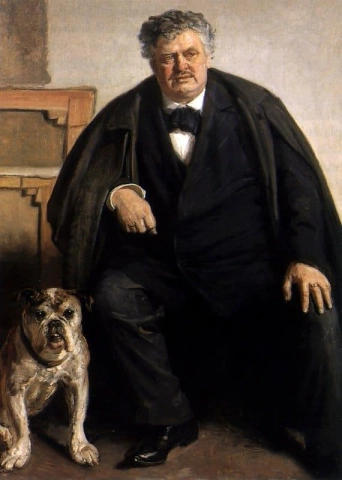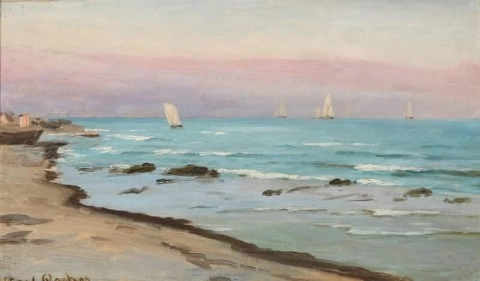

Hand painted reproductions of Carl Locher
Carl Locher: Danish Marine Painter and Master of Seascapes
Carl Locher (1851–1915) was a Danish painter known for his evocative seascapes and marine paintings. Renowned for his dramatic depictions of the sea, Locher captured the raw power of nature through the lens of romantic realism, using dynamic compositions, bold lighting, and an intimate understanding of maritime life. His works are marked by their attention to natural details and their profound emotional resonance, making him a key figure in the genre of marine painting in Denmark.
Early Life and Education
Born in Copenhagen in 1851, Carl Locher was exposed to the rich cultural atmosphere of Denmark from an early age. His childhood interest in art led him to study at the Royal Academy of Fine Arts in Copenhagen, where he received a classical education in painting. During his time at the Academy, Locher honed his skills in landscape and marine painting, drawing inspiration from the surrounding maritime landscapes and the historical significance of Denmark’s coastline.
While at the Academy, Locher was influenced by the Golden Age of Danish Painting, a period known for its focus on landscapes, particularly seascapes and nature. This era laid the groundwork for his artistic development, and he would eventually become associated with the Danish Realist movement, which emphasized realistic depictions of nature, often infused with romantic elements.
Artistic Development and Style
Locher’s painting style was deeply rooted in realism, yet it was imbued with the romantic ideals of his time. His primary focus was the depiction of the sea, coastal landscapes, and the lives of those who worked in the maritime world. Locher’s technical mastery and emotional depth can be seen in the way he portrays the vastness of the ocean, the ferocity of storms, and the tranquility of peaceful seascapes.
-
Seascapes and Marine Life: Locher’s seascapes are among his most iconic works. He captured the sea in all its moods, from the calm and serene to the tumultuous and stormy. His dramatic renderings of crashing waves, windswept shores, and ships battling the elements evoke the raw power of nature and the deep connection between humanity and the sea. Locher's attention to the details of maritime life—from the sails of ships to the texture of the sea foam—highlighted his technical expertise and personal engagement with the subject matter.
-
Dramatic Lighting and Composition: Locher was a master of using lighting to create mood in his paintings. He often depicted the sea at dusk or dawn, utilizing the dramatic interplay of light and shadow to convey the changing moods of nature. Whether it was the glow of the setting sun reflecting off the water or the eerie light of a storm on the horizon, Locher's mastery of lighting added depth and intensity to his works.
-
Naturalism and Realism: Locher’s seascapes are highly detailed, with meticulous attention to the movement of the waves, the texture of the ships, and the atmospheric conditions. His works are a testament to his commitment to realism, as he sought to represent nature not only with technical precision but also with a sense of emotional depth. The figures within his compositions—whether they are fishermen, sailors, or ships navigating rough seas—are portrayed with a sense of grandeur, reflecting the connection between people and the environment they inhabit.
-
Romanticism in Marine Art: While Locher was deeply influenced by the realism of his contemporaries, his work also exhibited elements of romanticism, especially in his depiction of the majesty and mystery of the sea. His works convey an emotional connection to the natural world, suggesting that the sea, with all its power and unpredictability, has a profound influence on human emotions and experiences.
Major Works and Themes
Locher’s most famous paintings often center around the sea and its relationship to human life. His works were exhibited widely in Denmark and throughout Europe, where they were praised for their technical virtuosity and emotional intensity.
-
"The Wreck of the Ship 'Adele'": One of Locher's most celebrated works is "The Wreck of the Ship 'Adele,'" which depicts a dramatic shipwreck in a stormy sea. The painting captures the chaotic violence of nature, with towering waves and dark, swirling skies threatening to engulf the ship. The intense action and emotive portrayal of the sea’s power make it a powerful example of Locher's ability to convey the vastness and danger of the ocean.
-
"The Calm after the Storm": In contrast to his stormy scenes, Locher also painted more tranquil moments, such as "The Calm after the Storm." This painting captures the serene, reflective nature of the sea after a storm has passed, with soft light casting a gentle glow over the water. The mood is peaceful, almost meditative, offering a stark contrast to the tumult of earlier works.
-
"Fishermen at Sea": Another important work by Locher is "Fishermen at Sea," which depicts a group of fishermen in small boats navigating the waters. The painting highlights the close relationship between people and the sea, as well as the precariousness of life on the water. The rough seas and the tiny boats evoke a sense of human vulnerability, as well as strength and resilience.
-
"The Danish Coastline": Locher also painted scenes of the Danish coastline, capturing the natural beauty of Denmark’s shores. These works often focused on the interplay between land and sea, showing the harmony of nature and the vitality of the coastal environment.
Recognition and Influence
During his lifetime, Carl Locher was highly regarded in Denmark and abroad. His works were displayed at major exhibitions, including the Royal Academy in Copenhagen and the Paris Salon. His ability to blend the romantic and realistic elements of marine painting helped to establish him as one of the leading Danish marine painters of his time. Locher’s works were praised not only for their technical mastery but also for their ability to evoke a strong emotional response from viewers.
Though Locher’s fame waned somewhat after his death in 1915, his legacy as a master of seascapes and marine realism endures. His paintings remain an important part of Denmark's artistic heritage and continue to inspire new generations of artists and admirers of marine art.
Legacy
Carl Locher’s artistic legacy is that of a painter who captured the dynamic relationship between humanity and the sea. His seascapes are timeless, showcasing the eternal power of nature and the enduring struggle of humans against the elements. Today, Locher’s works can be found in prominent collections in Denmark, including the Statens Museum for Kunst and various municipal galleries.
His mastery of marine painting set him apart from many of his contemporaries and established him as a key figure in the tradition of Danish realism and romantic landscape art.
Where to Find Reproductions of Carl Locher’s Art
For those interested in experiencing Carl Locher’s stunning depictions of the sea and maritime life, POD (Painting On Demand) offers oil painting reproductions of his finest works. These reproductions bring the spirit of the ocean, ships, and coastal life into contemporary homes, allowing admirers of marine art to connect with Locher’s emotional and dramatic portrayal of the natural world.
Imagine owning an original-style painting by one of the greatest artists in history. At POD, we offer you the chance to make this dream a reality. Each canvas is faithfully reproduced down to the smallest detail, allowing you to experience the beauty of the artist’s vision in your own home.
Our reproductions are crafted by experienced painters using the finest materials and time-honored methods. We are committed to delivering works of exceptional quality that will inspire and bring joy to your family for generations to come.






















































